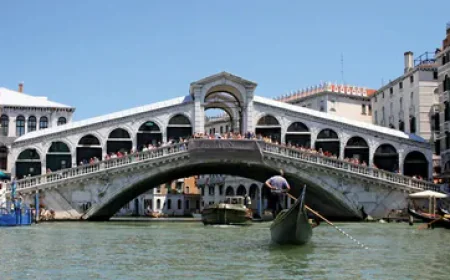From Wood to Stone: The 400-Year Legacy of Venice’s Iconic Rialto Bridge
When we imagine the beautiful and romantic Italian city of Venice, we often picture a city floating on water and boats. However, within this beauty of Venice, there's one structure that has become its hallmark: the Rialto Bridge. This bridge not only connects two shores, but also tells the story of Venice's rich heritage and its remarkable architecture.

Speaking about Venice as a city of romance, hardly will one be able to say a word without mentioning the Rialto Bridge. The Rialto Bridge, spanning the Grand Canal, is not only the heart of Venice but also a symbol that reflects the rich heritage and brilliant engineering of this city. Centuries have passed, yet this bridge has remained dear to the hearts of Venetians and travelers alike.
The Rialto Bridge has a history all the way back to the 16th century. In place of the beautiful stone bridge today, there used to be a wooden bridge. The bridge was essential for merchants, mainly due to the fact that it functioned as access to Venice's central commercial district, the Rialto Market. However, each time the bridge would suffer either from fires or collapses.
Finally, between 1588 and 1591, the renowned architect Antonio da Ponte rebuilt the bridge in stone. At the time, building such a single-arch bridge was a technological marvel. People feared that this massive stone bridge would collapse under its own weight, but today, 400 years later, it stands strong, as if holding history in its arms.
The most striking feature of the Rialto Bridge is its design. It is a single-arch bridge—meaning it has only one large arch connecting the two banks of the Grand Canal. The bridge is approximately 157 feet long and 72 feet wide. Made entirely of stone, rows of small shops line both sides of the bridge, selling glassware, jewelry, souvenirs, and handicrafts.
Want to get your story featured as above? click here!
Want to get your story featured as above? click here!
This is why this bridge is not just a thoroughfare but also a vibrant little market. During the day, locals and tourists alike create a wonderful atmosphere. Crossing the bridge and looking down at the Grand Canal, you truly experience the beauty of Venice.
The Rialto Market, located near the Rialto Bridge, can be called the heart of Venice. For nearly a thousand years, this market has been the economic pulse of the city. Even today, locals and tourists flock here to buy fresh fruits, vegetables, and seafood. Filled with colorful shops and bustling surroundings, this place offers a vibrant glimpse of old Venetian life.
The Rialto Bridge is not just a historical monument but also a cultural icon. It has been featured in numerous films, paintings, and literary works. When tourists pass beneath it in a gondola, they feel as if they are living a scene from a movie. In the evening, when the sunlight casts a golden glow on the bridge, it is a captivating sight.
Locals say, "The Rialto Bridge is not just a stone structure, but the soul of Venice." This bridge not only connects the two sides of the city, but also becomes a bridge between the past and the present. It reminds us that architecture is not just a construction, but a confluence of culture and emotion.
Today, the Rialto Bridge is at the top of every tourist's list. Viewing the Grand Canal from here or taking a gondola ride is a breathtaking experience. The bridge's strength, standing strong for four centuries, is a symbol of Venice's beauty and its unbroken history.




































.jpeg)
































































































